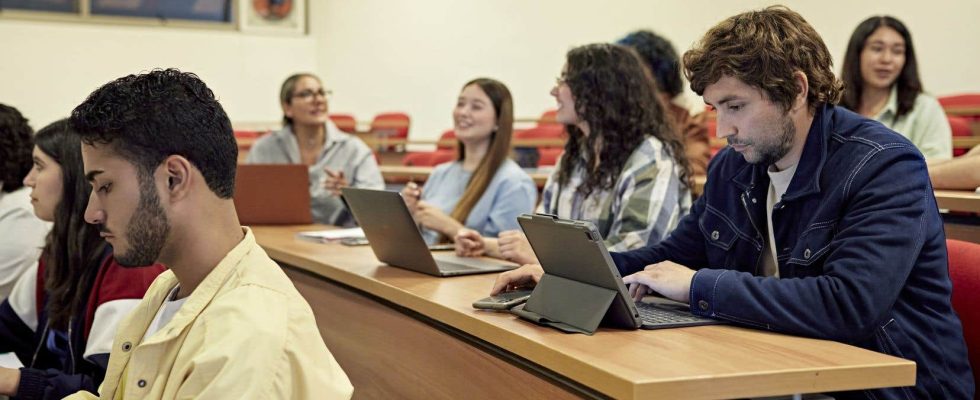This text is part of the special notebook Relève en recherche
More and more students with disabilities are entering post-secondary education. From 2016 to 2021, the public college network recorded an increase in registrations of 20% according to the most recent government data. Universities, for their part, saw this audience increase by more than 50% during the same period, according to the Quebec Interuniversity Association of Advisors to Students with Disabilities (AQICESH).
Among these students, more than 65% suffer from one or more learning disabilities (LD), including attention deficit disorders (ADD) which are also of neurological origin and are concomitant with them. “A person with dyslexia has a high probability of having an attention deficit,” emphasizes Lucille Doiron, general director of the Institute of Learning Disabilities.
Early detection, an advantage
LD, which interferes with the acquisition of reading, writing or mathematics skills, is increasingly better supported by primary and secondary establishments, according to professionals in the sector. Schools are also required to offer accommodations to students in difficulty, particularly in the form of support for the transition to college, without the obligation of a diagnosis. “This increases the high school graduation rate, even if the process takes seven years. As a result, more students with special needs end up in CEGEP,” indicates Lucille Doiron.
If more of these students access postsecondary education, are they well prepared? The question arises in view of the graduation rate of CEGEP students which has hovered around 63% for 20 years.
“Students who come to us and have benefited from an intervention plan since they were at school are generally 100% independent […] they know each other better,” says Émilie Lanthier, coordinator of the Student Integration Assistance Service at Cégep du Vieux Montréal (SAIDE).
The difficulties arise more from students who are not known to the service and discover a learning disability late in life, believes the coordinator. “These are often students that the health system struggles to support because they go from childhood to adulthood, without a family doctor and without screening for anything. »
The pandemic has also left its mark, placing students in more flexible working conditions than those they found in person. “We could give a week’s deadline to submit work that would be requested today in 3 hours,” indicates Émilie Lanthier, who believes that this gap has led to an increase in the number of students with disabilities at the Cégep du Old Montreal. “There was a boom, they went from around 15% before the pandemic to almost 20%.”
Individualized support
However, solutions exist for students who come forward and mobilize to succeed, assures the coordinator. If support for organization and access to software to support reading or correction form the bulk of students’ requests, they can also benefit from support for social skills, anxiety management as well as than specialized tutoring. A reduction in timetables, with an extension of the course, can also be implemented.
The ability of students to adapt to college education is an indicator of their willingness to pursue a university career. At the University of Quebec at Chicoutimi (UQAC), 450 students were identified with disabilities during the 2020-2021 year. “These students are well prepared by the CEGEP. Often they already have a good command of their compensatory tools,” estimates Eve Simard, advisor to students with disabilities at UQAC and vice-president of AQICESH.
As at Cégep du Vieux Montréal, the support offered to UQAC students tends to respond to their specific needs rather than being based on a diagnosis. “We are attentive to the effects that the condition has on the student’s academic career, depending on the program in which they are. It is only then that we look at the appropriate accommodations,” underlines the advisor.
Students with learning disabilities can benefit from additional time for exams, access to specialized software, organizational help as well as adapted educational formats, such as digital formats allowing them to use speech synthesis tools, or even audio formats.
Open up to other options
If the monitoring of students with LD is strengthened at post-secondary level, those who embark on this level of study are not protected from dropping out. Other options exist, however, and vocational training can even serve as a springboard for entry into CEGEP, maintains Lucille Doiron. “Sometimes the step is too high. Learning a profession that they love can then allow the student who wishes to improve their skills to find themselves at college with greater ease and enhanced self-esteem. »
Furthermore, these students often develop resources that allow them to go where they want, believes Eve Simard, their difficulty leading them to have to demonstrate determination and perseverance in their journey. “This applies to all people with disabilities — they will not be discouraged at the first hurdle. I think we can talk about resilience. »
This content was produced by the Special Publications team at Duty, relating to marketing. The writing of the Duty did not take part.
